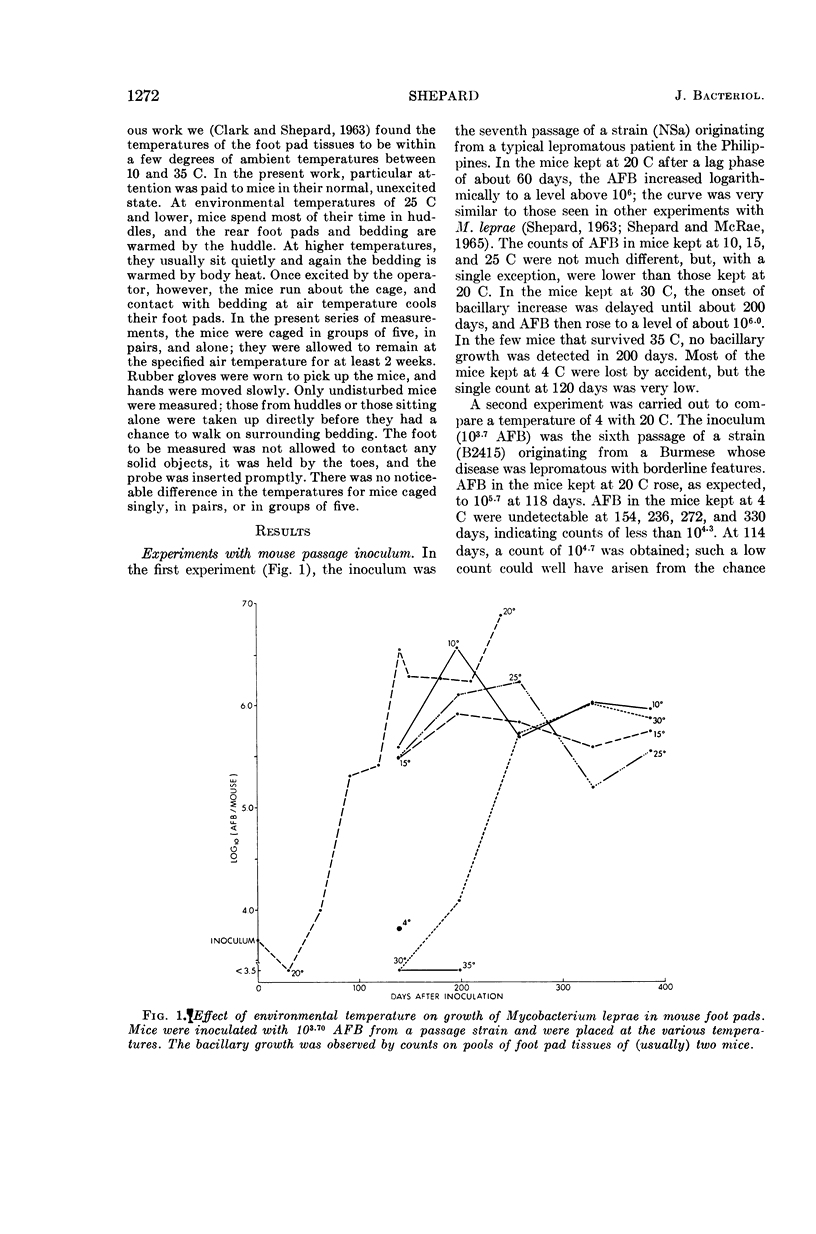Abstract
Shepard, Charles C. (Communicable Disease Center, Atlanta, Ga.). Temperature optimum of Mycobacterium leprae in mice. J. Bacteriol. 90:1271–1275. 1965.—Mycobacterium leprae multiplied most rapidly in foot pads of mice kept at an air temperature of 20 C. At air temperatures of 15 and 25 C, bacillary multiplication was slightly slower; at 10 and 30 C, distinctly slower; and at 4 and 35 C, no bacillary multiplication was detected. The temperature of the foot pad tissues of mice kept at an air temperature of 20 C averaged 27 to 30 C and that of mice kept at 10 and 30 C averaged about 25 and 36 C, respectively. These measurements indicate that the optimal temperature for the growth of M. leprae in mice is in the range several degrees above and below 30 C. The comparative effect of different air temperatures on the growth of M. leprae in foot pads was very similar to that found earlier for M. marinum in this site, thus indicating that the potential growth of M. leprae in vitro might have a similar optimum to M. marinum in vitro, i.e., 25 to 35 C. The optimal temperature for the growth of M. leprae appears to be the same in mice as in humans. It is pointed out that the temperature optimum of M. leprae may be a reflection of the fact that most of the bacilli being excreted into the environment, where they may reach new hosts, have multiplied in the nasal mucosa, a cool tissue.
Full text
PDF




Selected References
These references are in PubMed. This may not be the complete list of references from this article.
- BRAND P. W. Temperature variation and leprosy deformity. Int J Lepr. 1959 Jan-Mar;27(1):1–7. [PubMed] [Google Scholar]
- CLARK H. F., SHEPARD C. C. EFFECT OF ENVIRONMENTAL TEMPERATURES ON INFECTION WITH MYCOBACTERIUM MARINUM (BALNEI) OF MICE AND A NUMBER OF POIKILOTHERMIC SPECIES. J Bacteriol. 1963 Nov;86:1057–1069. doi: 10.1128/jb.86.5.1057-1069.1963. [DOI] [PMC free article] [PubMed] [Google Scholar]
- Palmer E., Rees R. J., Weddell A. G. Site of multiplication of human leprosy bacilli inoculated into the foot-pads of mice. Nature. 1965 May 1;206(983):521–522. doi: 10.1038/206521a0. [DOI] [PubMed] [Google Scholar]
- SHEPARD C. C., MCRAE D. H. MYCOBACTERIUM LEPRAE IN MICE: MINIMAL INFECTIOUS DOSE, RELATIONSHIP BETWEEN STAINING QUALITY AND INFECTIVITY, AND EFFECT OF CORTISONE. J Bacteriol. 1965 Feb;89:365–372. doi: 10.1128/jb.89.2.365-372.1965. [DOI] [PMC free article] [PubMed] [Google Scholar]
- SHEPARD C. C. The nasal excretion of Mycobacterium leprae in leprosy. Int J Lepr. 1962 Jan-Mar;30:10–18. [PubMed] [Google Scholar]
- TYRRELL D. A., BYNOE M. L., HITCHCOCK G., PEREIRA H. G., ANDREWES C. H. Some virus isolations from common colds. I. Experiments employing human volunteers. Lancet. 1960 Jan 30;1(7118):235–237. doi: 10.1016/s0140-6736(60)90166-5. [DOI] [PubMed] [Google Scholar]


